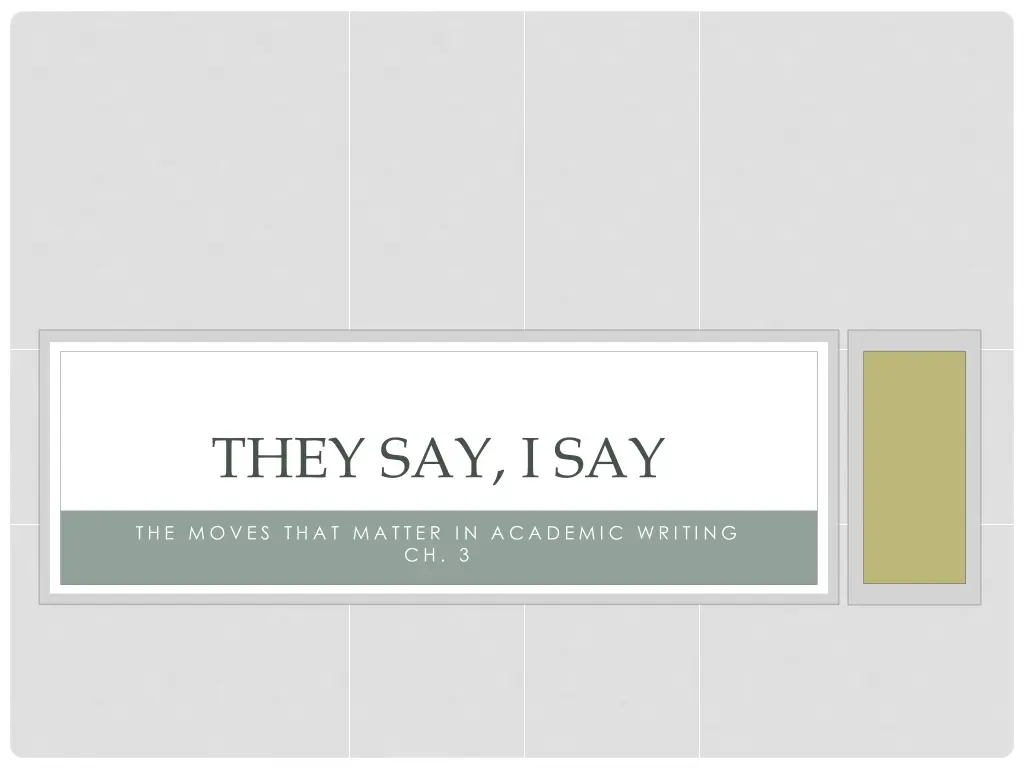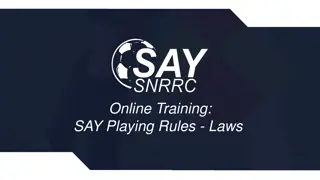
Mastering Academic Writing: The Art of Incorporating Quotations
Learn the essential moves in academic writing with "They Say, I Say" focusing on the art of quoting. Discover the importance of integrating relevant quotations effectively into your arguments, avoiding common pitfalls like over-quoting or hit-and-run quotations.
Download Presentation

Please find below an Image/Link to download the presentation.
The content on the website is provided AS IS for your information and personal use only. It may not be sold, licensed, or shared on other websites without obtaining consent from the author. If you encounter any issues during the download, it is possible that the publisher has removed the file from their server.
You are allowed to download the files provided on this website for personal or commercial use, subject to the condition that they are used lawfully. All files are the property of their respective owners.
The content on the website is provided AS IS for your information and personal use only. It may not be sold, licensed, or shared on other websites without obtaining consent from the author.
E N D
Presentation Transcript
THEY SAY, I SAY T H E M O V E S T H A T M A T T E R I N A C A D E M I C WR I T I N G C H . 3
CH. 3: AS HE HIMSELF PUTS IT THE ART OF QUESTIONING A key to any effective argument is to write the arguments of others into your text (42). - You can do this by summarizing what they say but also by quoting their direct words as well. - Quotations serve as a kind of proof that you know about what they say and have worked others arguments into your own
QUOTING Issues with quoting: Not quoting enough, quoting too little Maybe you think you can do it from memory or not wanting to go back to the source Over quoting too is an issue Makes your commentary, your words, short. This shows a lack of confidence in your ability which shows The main problem: Writers assume that quotations speak for them. They are not always self-evident to a reader that they may be to you
PROBLEM Its more than about simply including a quotation in your work, more than simply inserting what they say. Quotations are orphans (43). They have been taken from their original contexts and they need to be integrated into their new textual surroundings (43). Keys to integration 1. Choose good quotations 2. Framing them well
QUOTE RELEVANT PASSAGES Know what you want the quotation to do for you: how will they support your argument, your point of view (43). The authors warn to Be careful not to select quotations just for the sake of demonstrating that you ve read the author s work; you need to make sure they support your argument (43)
FRAME EVERY QUOTATION You need to be aware of the relevance and make sure the meaning of quotations are clear to your reader (44). Keep in mind that quotations do not speak for themselves, you need to build a frame around them in which you do that speaking for them (44). Hit-and-Run quotations: quotations that make an impact and then run off with no explanation
EXAMPLE OF A HIT AND RUN QUOTATION The text gives the following example: Susan Bordo writes about women and dieting. Fiji is just one example. Until television was introduced in 1995, the islands had no reported cases of eating disorders. In 1998, three years after programs from the United States and Britain began broadcasting there, 62 percent of the girls surveyed reported dieting. I think Bordo is right. Another point Bordo makes is that What is the problem with this example?
TEMPLATES FOR INTRODUCING QUOTATIONS X states, not all steroids should be banned from sports. As the prominent philosopher X puts it, . According to X, . In her book, , X maintains that . Writing in the Journal Commentary, X complains that . X agrees when she writes, . X disagrees when he writes, . X complicates matters further when she writes, .
TEMPLATES FOR EXPLAINING QUOTATIONS Basically, X is warning that the proposed solution will only make the problem worse. In other words, X believes . In making this comment, X urges us to . X is corroborating the age-old adage that . X s point is that . The essence of X s argument is that .
REVISING OUR HIT AND RUN QUOTATION Here s from the text: The feminist philosopher Susan Bordo deplores Western media s obsession with female thinness and dieting. Her basic complaint is that increasing numbers of women across the globe are being led to see themselves as fat and in need of a diet. Citing the islands of Fiji as a case in point. Bordo notes that until television was introduced in 1995, the islands had no reported cases of eating disorders. In 1998, three years after programs from the United States and Britain began broadcasting there, 62 percent of the girls surveyed reported dieting (149-50). Bordo s point is that the Western cult of dieting is spreading even to remote places across the globe. Ultimately, Bordo complains, the culture of dieting will find you, regardless of where you live. Bordo s observations ring true to me because, now that I think about it, most women I know, regardless of where they are from, are seriously unhappy with their weight
BLEND THE AUTHORS WORDS WITH YOURS Noting the Bordo passage 1. Framing allows writer to spin the author s words without misrepresenting them 2. The writer refers and reinforces the key concepts that Bordo is making 3. The follow up to the quotation is strong because it takes from Bordo s words and moves them in the direction the author is going
OVERANALYZING General Rule: the most explanatory framing is needed for quotations that may be hard for readers to process (49). It is better to risk over explaining than to under explain the quotation
HOW NOT TO INTRODUCE QUOTATIONS Bad ways to introduce quotations: 1. Orwell asserts an idea that 2. A quote by Shakespeare says These phrases are redundant and misleading. - The first example would work better as Orwell asserts that or Orwell s assertion is that to avoid redundancy - The second example is misleading because it is the reader quoting, not Shakespeare
CH. 3 - EXERCISES Look over something that you have written for one of your classes (this one could work). Have you quoted any sources? LOOK at your Background/Summary work for Writing Workshop 1. If so, how have you integrated the quotation into your own text? How have you introduced it? Explained what it means? Indicated how it relates to your text? If you haven t done all these things, revise your text to do so, perhaps using the Templates for Introducing Quotations and Explaining Quotations.





![READ [PDF] Trickster Caught: An Alien Gladiator Romance (Gladiators of the Vaga](/thumb/42236/read-pdf-trickster-caught-an-alien-gladiator-romance-gladiators-of-the-vaga.jpg)
















